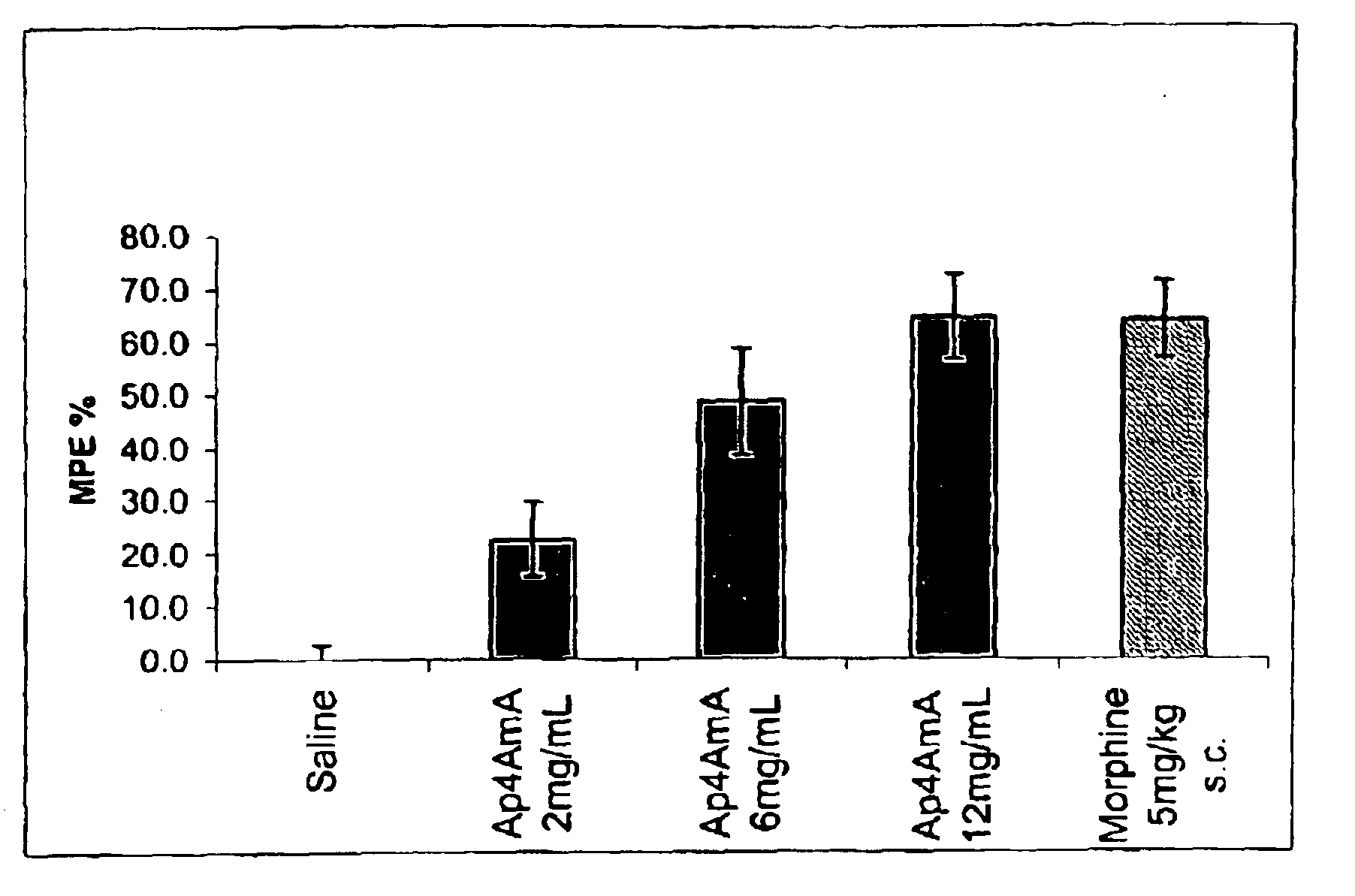Method for treating pain
a pain and pain technology, applied in the field of pain treatment methods and pharmaceutical compositions, can solve the problems of increased bleeding time, gastrointestinal side effects, and limitations of all therapies, and achieve the effect of enhancing the therapeutically desired effect of pain reduction
- Summary
- Abstract
- Description
- Claims
- Application Information
AI Technical Summary
Benefits of technology
Problems solved by technology
Method used
Image
Examples
example 1
Effects of AP4AmA in the Hotplate Assay for Acute Pain in Mice
[0147]The action of P1-5′-[2′-(O)—,3′-(O)-(benzyl)methylenedioxy]adenosine-P4-5″-adenosine tetraphosphate, (AP4AmA; AP4A-2′, 3′-mono-acetal with phenylacetaldehyde) on mice in the hotplate model illustrates the analgesic affect of compounds of Formula I. The temperature of the hot plate was set at 55 degrees Celsius. Animals were administered subcutaneously AP4AmA or saline into the dorsal aspect of both hind paws in a volume of 20 microliters. This administration occurred 5 minutes prior to placement on the hotplate. Morphine was administered subcutaneously into the back nape of the mouse's neck in a volume of 10 mL / kg.
[0148]The time to hindpaw lick was used as the efficacy endpoint. If the animals did not lick their hindpaws after 36 seconds then they were considered to be fully protected to the hotplate induced algesia. The raw averages were then converted to a maximum percent effect, MPE %, by normalizing the response...
example 2
Effects of AP4AmA on the Abdominal Constriction Assay for Visceral Pain in Mice
[0150]These examples illustrate the effects of AP4AmA in two similar models of abdominal constriction; acetic acid-induced and phenylbenzoquinone-induced constrictions in mice. The method employed in FIGS. 2A and 23B was a modification of the abdominal constriction test described by Collier et. al (Collier, H, O. et. al, Br. J. Pharmacol. Chemother. 32:295-310 (1968)).
[0151]Briefly, in FIG. 2A, each animal, received an intraperitoneal (i.p.) injection of 0.9% acetic acid in a volume of 10 mL / kg. The mouse was placed in an observation chamber shortly after the acetic acid injection and allowed to explore. Testing started five minutes after the acetic acid injection and consisted of 10 minutes of observation during which the number of abdominal constrictions was counted. Abdominal constriction was defined as a lengthwise stretching of the torso with concave arching of the back. AP4AmA and vehicle were admin...
example 3
Effects of AP4AmA on the Formalin Assay for Inflammatory Pain in Mice
[0154]This example illustrates the effect of AP4AmA in mice in phase II of the formalin assay for persistent inflammatory pain. In brief, mice were injected 20 microliters of a 5% full strength formalin solution subcutaneously (s.c.) into the dorsal aspect of the right hindpaw. The mice were returned to the observation cage. The mice were injected 10 microliters s.c. into the same dorsal aspect of the right hindpaw with either vehicle or AP4AmA in varying concentrations 10 minutes after the formalin injection. They were returned to the observation cages and the number of times they licked their right hind foot was counted from the 10 minutes to the 30 minutes post formalin administration.
[0155]FIG. 3 shows the action of AP4AmA in the mouse in a preclinical model of inflammatory somatic pain (the formalin model, persistent pain phase). The results clearly illustrate a dose dependent pharmacological effect of AP4AmA ...
PUM
 Login to view more
Login to view more Abstract
Description
Claims
Application Information
 Login to view more
Login to view more - R&D Engineer
- R&D Manager
- IP Professional
- Industry Leading Data Capabilities
- Powerful AI technology
- Patent DNA Extraction
Browse by: Latest US Patents, China's latest patents, Technical Efficacy Thesaurus, Application Domain, Technology Topic.
© 2024 PatSnap. All rights reserved.Legal|Privacy policy|Modern Slavery Act Transparency Statement|Sitemap



